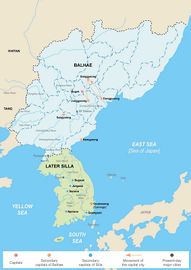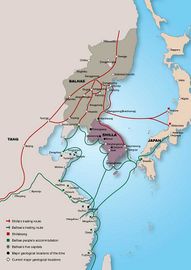"A Spirit Akin to Goguryeo - Balhae"의 두 판 사이의 차이
| 2번째 줄: | 2번째 줄: | ||
|Article= 고구려를 닮은 기상, 발해 | |Article= 고구려를 닮은 기상, 발해 | ||
}} | }} | ||
| + | |||
| + | Balhae was a state in the northern Korean peninsula and Manchuria, which existed concurrently with [[신라|Silla kingdom]] to the south. This period is therefore referred to by historians as the North-South States period. Balhae was first established under the name Jin by [[Goguryeo]] general [[Dae Jo-yeong]] (King Go) after his defeat of [[Tang China]] at Tianmenling. It was renamed Balhae in 762. Its government was modeled after [[Tang China]] and its culture was rooted in [[Goguryeo]]. | ||
| + | |||
| + | There is controversy surrounding Balhae, namely about the ethnicity of its founder and the of the people that lived within its territories. It was considered a successor state to the Korean state of [[Goguryeo]], however there were many [[Mohe]] and [[Malgal]] people living in the area as well. While Dae Jo-yeong was certainly a Goguryeo person, records do not state whether he was ethnically Korean or Mohe. However, "archaeological records suggest the culture was an amalgamation of Chinese, Korean, and indigenous cultures.”<ref>Encyclopaedia of Korea</ref>. | ||
<gallery mode=packed heights=180px> | <gallery mode=packed heights=180px> | ||
2017년 11월 22일 (수) 13:02 기준 최신판
Balhae was a state in the northern Korean peninsula and Manchuria, which existed concurrently with Silla kingdom to the south. This period is therefore referred to by historians as the North-South States period. Balhae was first established under the name Jin by Goguryeo general Dae Jo-yeong (King Go) after his defeat of Tang China at Tianmenling. It was renamed Balhae in 762. Its government was modeled after Tang China and its culture was rooted in Goguryeo.
There is controversy surrounding Balhae, namely about the ethnicity of its founder and the of the people that lived within its territories. It was considered a successor state to the Korean state of Goguryeo, however there were many Mohe and Malgal people living in the area as well. While Dae Jo-yeong was certainly a Goguryeo person, records do not state whether he was ethnically Korean or Mohe. However, "archaeological records suggest the culture was an amalgamation of Chinese, Korean, and indigenous cultures.”[1].
Related Articles
References
- ↑ Encyclopaedia of Korea

